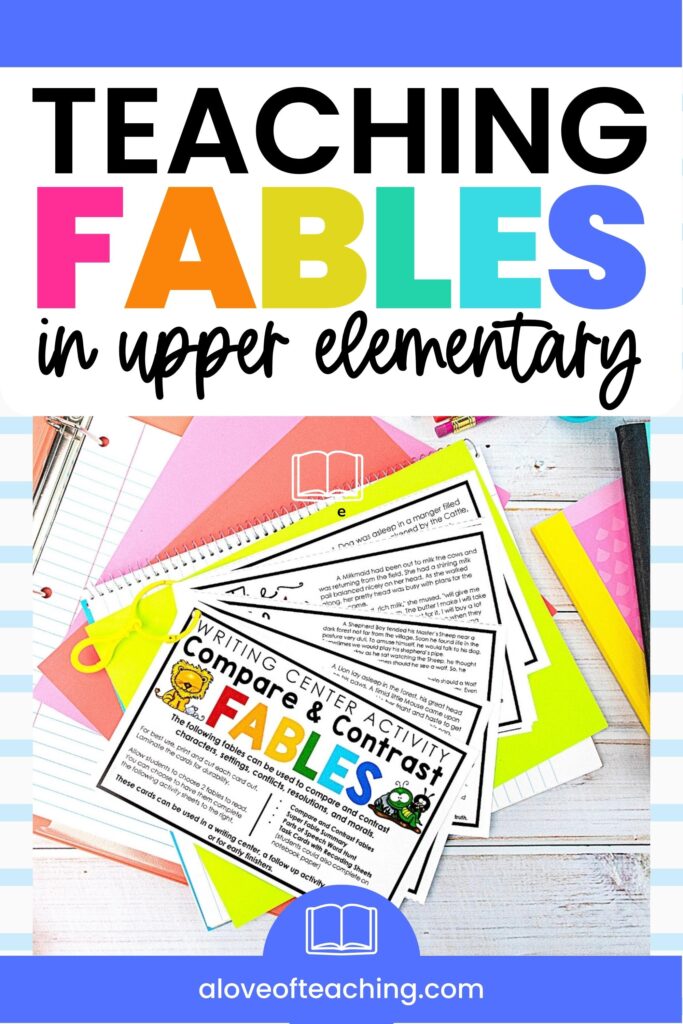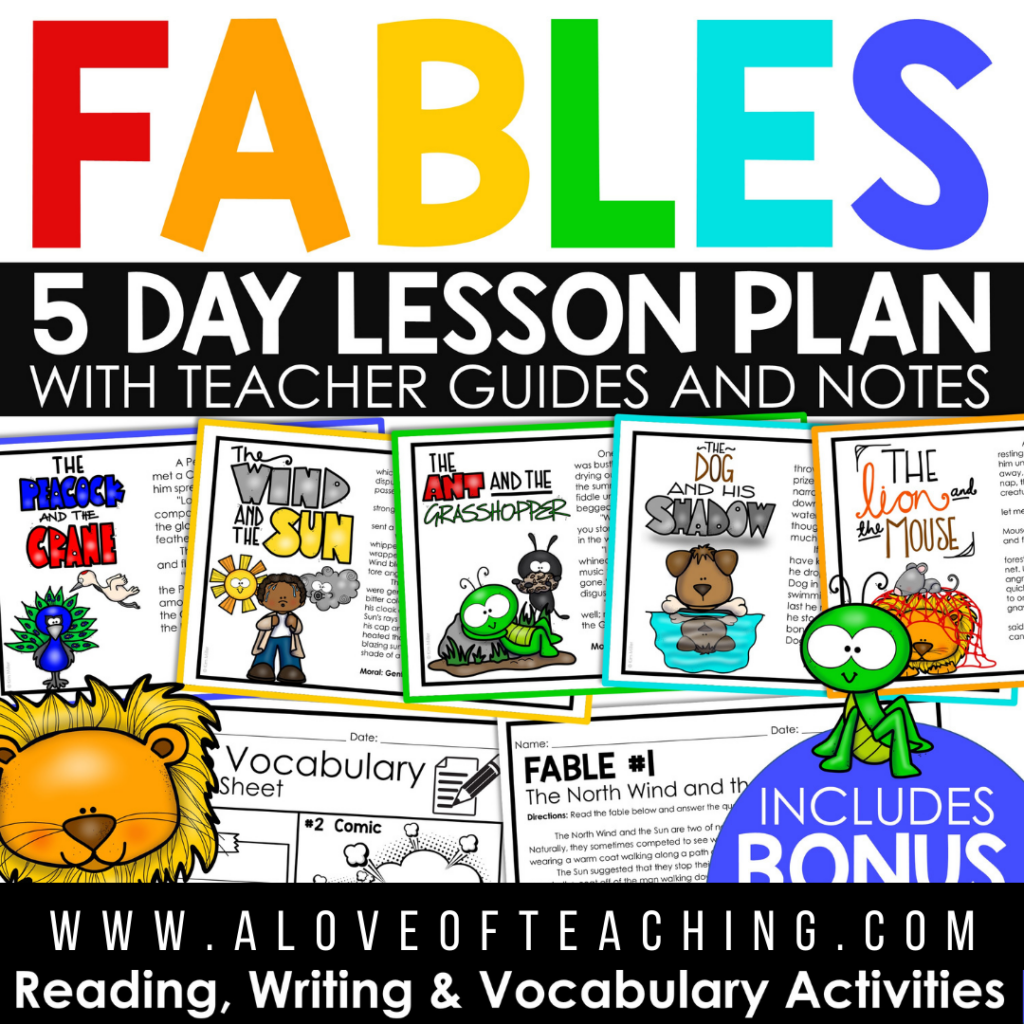Easy Sub Plans Using Aesop’s Fables
As 3rd, 4th, or 5th grade teachers, finding engaging learning activities can be tough. A high-interest lesson plan that lasts longer than a day is always needed! Look no further than teaching fables! This collection of classic Aesop’s Fables, with often humorous tales, can provide great opportunities to practice literacy skills with your students while also allowing them creative expression through discussion and writing activities. These easy lesson plans focus on learning life lessons through timeless stories while students are still practicing necessary skills.
Teaching fables is so much fun, and these quick and easy lessons are jam-packed with teachable moments. Specifically, the fable lessons are a great way to teach morals and what is socially acceptable. Honestly, the value that fables will teach your students is hard to find through other sources. Essentially, fables are part of growing up and should be taught to all. Today I’m going to share tips for teaching fables in upper elementary.

Fables
I found that I had to spend hours looking for resources to piece together to create a comprehensive fable unit. I’m sure most of you share this problem. I was tired of the rat race, so I decided to put together a fable lesson that was complete with teacher guides and notes. It has everything you need to teach your class all about fables.
The unit is very flexible. You can follow it as written, or you can pick and choose which activities you’d like to complete. The great thing is that you can add these fables and activities to any traditional literature unit.
I have broken the lesson down into a 5-day plan. Through the years, I’ve found this to be the most effective way to present the information.
Teaching Fables
Day 1: Introducing Fables
As always, the first day of a new lesson is all about introductions. It is important to cover vocabulary and the main idea of the skill or topic. This lays the foundation for days ahead and makes sure that everyone is on the same page. Having the same background knowledge created through the introduction allows for great discussion in future lessons. I like to do this in several different ways.
- Read a fable or watch a fable video
- Display a poster about Fables
- Use Fable vocabulary cards in a pocket chart
These vocabulary words should be introduced together and then reinforced through vocabulary centers or small group lessons.
Next, it’s time to introduce Aesop – the creator of many fables. A “Who Was Aesop” activity and comprehension sheet are included in the resource. I like to read the passage from the activity together and then have my students complete the questions independently.
To wrap up day 1, we create a book about fables using all of our new knowledge. There are two versions available depending on the level and needs of your students. One has blank pages so that you can guide them to fill in the blanks, and the other is already filled in for them. This booklet serves as a great reference tool throughout the unit when teaching fables in upper elementary.
Day 2: Comparing and Contrasting Fables
Day 2 begins with a quick review of vocabulary words. I like to make a game of reviewing these words. I read the definition and then have students write the word on a whiteboard and hold it up. You can also add a little movement by posting the words around the room and having students move to the word that matches the definition.

After the vocabulary game is a great time to have students finish up the Fables Booklet from day 1 if it is not already complete, this makes a great reinforcement of words. I like to secure their booklets with these metal book rings. Honestly, your students will feel accomplished seeing their completed Fables Booklet!
Next, we move into one of our main reading comprehension skills in this unit – comparing and contrasting. I like to start this activity as a group because it is a great way to model the activity and review important thinking steps for comparing and contrasting. We chose two fables from the story cards included in the lesson. After reading through them, we do a compare and contrast activity.
The first one is always done on the board–discussion style. So, depending on how your students are doing, you can do more than one or move them into completing the same activity with a partner or small group. You can have them work with partners to complete this activity or do it together as a group. I prefer whole group instruction.
Day 3: Summarizing Fables
Begin day 3 with a vocabulary review while completing the Key Vocabulary Fables activity. I’ve found that doing this daily review really helps students learn these words. And . . . by spreading the activities out, students have time to assimilate the information they are learning.
Our focus on Day 3 is summaries. Super Fable Summaries is a fun small group activity that gets students working together, discussing, and summarizing! I like to give 2-3 students a pair up and choose 1 Aesop’s Fables from the story cards. They will work together to complete the Super Fable Summary Sheet. The students love focusing on the most important parts of the fable and then summarizing them in words and pictures.
For the most part, I’ve found that by completing this activity in a small group, students have a rich discussion of the fable and summarizing. It’s a great way to review this important reading skill.
Day 4: Reading Comprehension & Teaching Fables

Any guesses as to what you’ll begin with on Day 4? Yep! You guessed it, vocabulary review. Practice makes perfect. At this time in the week, students will start using their new vocabulary words in their discussions.
Today we take our reading comprehension skills to an individual level. Students will complete their first fable reading passage and answer the questions. Specifically, the questions cover basic comprehension, vocabulary, parts of speech, context clues, and more. Moreover, there are even some short response questions to get kids writing about the fable.
This comprehension activity is a great way for me to do an informal assessment to see where everyone is. And then, with one day left in my lesson plan, I have time to reteach misunderstandings if needed.
Day 5: Teaching Fables with Writing
Day 5 is the last day of our fable unit, but don’t worry, it is jam-packed with lots of fable fun! Before starting our first fable activity, I take a little time to review or go over anything I noticed from the first fable comprehension passage. Then, students will jump in with a second fable and reading comprehension activity. Your students will love reading “The Dog and His Shadow” while completing the comprehension questions.
Our focus on this last day is writing, and this writing activity is one of my favorites. With a little guidance, students will write their own fable! This is a class favorite activity year after year.
Students will first read “The Elements of a Fable” and choose a card with a moral. Next, they will then complete the guided writing activities. Starting with the “Fable Writing Guide,” students will plan out their fable and make sure they are meeting all the elements. This guide will help them through planning all the important parts of their fable. Lastly, with their planning done, students will write their own fable. Not only do students love doing this, but sharing the fables at the end is so much fun.
It’s fun to have students read their fable and then let the class guess what the moral is. I’m always amazed by their creativity and thoughtfulness in this writing activity.
Grab Your Fable Lessons
You can grab all of these fable lessons and activities (and more) in the A Love of Teaching store. This Fables unit includes 5 days of lesson plans with detailed teacher guides and notes. In addition, all the teaching aids and activities you need to teach those lessons is included. This means no scouring the internet for fables or activities–it’s all here in one resource! Most importantly, you will have everything you need for teaching fables!
Save these Tips for Teaching Fables
Be sure to pin this to your favorite classroom Pinterest board so you can come back the next time you are teaching fables in your classroom.






